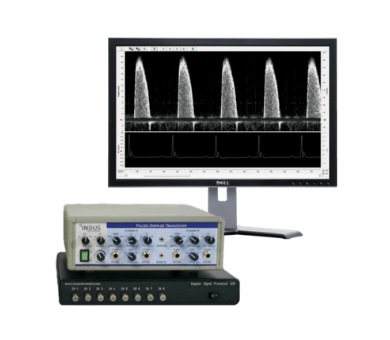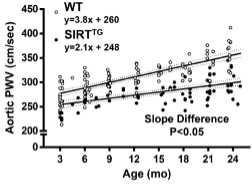System Used:
Doppler Flow Velocity System

 In the United States, there is a progressive increase in cardiovascular diseases (CVDs) related to aging. The prevalence of advancing age-related deaths associated with CVDs has highlighted the important research efforts to understand the cause, treatment, and prevention of age-related CVD.
In the United States, there is a progressive increase in cardiovascular diseases (CVDs) related to aging. The prevalence of advancing age-related deaths associated with CVDs has highlighted the important research efforts to understand the cause, treatment, and prevention of age-related CVD.
One cause/consequence of CVDs in aging is the change of arterial phenotype from elastic to stiffened arteries. Arterial stiffness is a non-invasive indicative measure of CVD severity and progression and is associated with an increased risk of cardiovascular events. So, reversing age-related arterial stiffening is a priority target of treatment. Aortic stiffness is typically assessed using ultrasound Doppler flow velocity measurements to determine pulse wave velocity (PWV) in a particular vessel. Research has shown that advanced-age aortic stiffening is associated with decreasing sirtuin-1 (SIRT-1) expression. Previous caloric restriction studies have shown that SIRT-1 KO ameliorates the caloric restriction protective effect of vascular stiffening with aging. Reciprocally, would increasing SIRT-1 expression amend age-related aortic stiffness?
Daniel R. Machin in Anthony J. Donato’s lab at the University of Utah, published that SIRT-1 overexpression attenuates stiffening of the major vasculature with aging. They did this in 3-24 months SIRT-1 transgenic overexpressing and control mice. The primary outcome measure was the change in aortic PWV over time through parallel non-invasive measurements with ultrasound Doppler flow velocity at 3-month intervals. Generally, increased velocity is associated with increased stiffening of the blood vessel. Histology of the aorta, for both morphology and composition, was assessed to corroborate the in vivo findings at approximately 6, 12, and 24 months of age.

The study suggests that with aging (3-24 mo), PWV increase in presence of SIRT-1 overexpression is about 40% lower compared to control. Histology further showed that aortic elastin content decrease was ameliorated in the SIRT-1 overexpressing mice. Conversely, the age-associated increase in aortic collagen, advanced glycation end products, and calcification seen in controls were similarly ameliorated in the SIRT-1 overexpressing mice. As permanent SIRT-1 overexpression can reduce age-related aortic stiffening, it can be highlighted as a viable interventional target for further investigation.
Reference:
Machin DR, Auduong Y, Gogulamudi VR, Liu Y, Islam MT, Lesniewski LA, Donato AJ. Lifelong SIRT-1 overexpression attenuates large artery stiffening with advancing age. Aging (Albany NY). 2020 Jun 20;12(12):11314-11324. doi: 10.18632/aging.103322. Epub 2020 Jun 20. PMID: 32564006; PMCID: PMC7343505.
For more information about the Doppler Flow Velocity System or our preclinical ultrasound systems, please contact Scintica Instrumentation (info@scintica.com)
